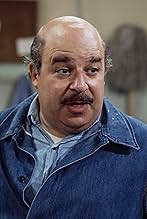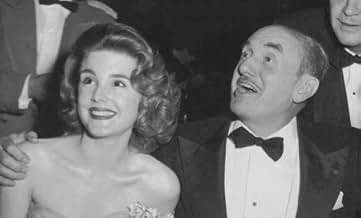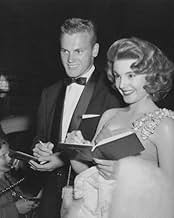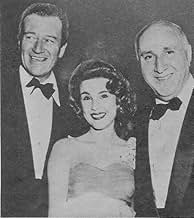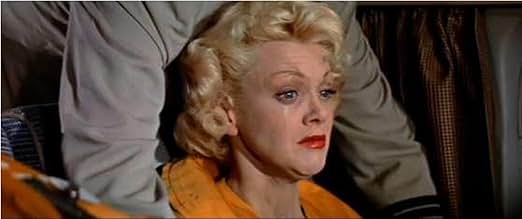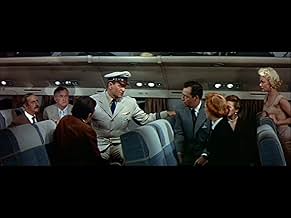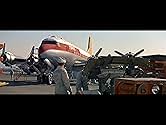IMDb RATING
6.6/10
6.9K
YOUR RATING
When a commercial airliner develops engine problems on a trans-Pacific flight and the pilot loses his nerve, it is up to the washed-up co-pilot Dan Roman to bring the plane in safely.When a commercial airliner develops engine problems on a trans-Pacific flight and the pilot loses his nerve, it is up to the washed-up co-pilot Dan Roman to bring the plane in safely.When a commercial airliner develops engine problems on a trans-Pacific flight and the pilot loses his nerve, it is up to the washed-up co-pilot Dan Roman to bring the plane in safely.
- Won 1 Oscar
- 5 wins & 7 nominations total
Pedro Gonzalez Gonzalez
- Gonzales
- (as Gonzalez Gonzalez)
Featured reviews
Probably the most popular film that has never been released to any video medium, The High and the Mighty is th4e granddaddy of all of those disaster pictures that became popular in the 70s, but they do not hold a candle to this one.
The Wayne Family in general, and I would assume sons Michael and Patrick in particular, own the film along with some others. One has to wonder why they do not release it. I have a copy I recorded from HBO many years ago and when aired it was a great print. I am fortunate to be able to see it now and then at my own leisure.
The plot of a crippled airliner in the middle of the Pacific doesn't accurately describe this film. It is a true character study with some of the finest actors of the day on hand delivering brilliant performances. Those that stand out include Jan Sterling (oscar nominee and Golden Globe winner), Claire Trevor (Oscar nominated), Phil Harris, Robert Newton, and David Brian. But each and every one in the rest of the cast can take a bow for a job well done. And That includes Wayne himself. His Dan Roman is complete, a man with strengths and weaknesses, but a man who eventually is the only one to step up in a time of crisis. It is one of his best performances.
William Wellman's direction keeps the film moving, Dimitri Tiomkin's Oscar winning score had viewers whistling along with Whistling Dan.
Mike and Pat, please let this one out before it becomes an antique. A new generation of your father's fans await this classic. It is not fair to deny them their chance to see him. And by the way. John Wayne was not the original choice to play Dan Roman. When He acquired the rights to the film he just wanted to produce it ( a la Bullfighter and the Lady). His choice wanted to play the role, but schedule conflicts prevented this, thus John Wayne had to play the role he offered to Spencer Tracy
The Wayne Family in general, and I would assume sons Michael and Patrick in particular, own the film along with some others. One has to wonder why they do not release it. I have a copy I recorded from HBO many years ago and when aired it was a great print. I am fortunate to be able to see it now and then at my own leisure.
The plot of a crippled airliner in the middle of the Pacific doesn't accurately describe this film. It is a true character study with some of the finest actors of the day on hand delivering brilliant performances. Those that stand out include Jan Sterling (oscar nominee and Golden Globe winner), Claire Trevor (Oscar nominated), Phil Harris, Robert Newton, and David Brian. But each and every one in the rest of the cast can take a bow for a job well done. And That includes Wayne himself. His Dan Roman is complete, a man with strengths and weaknesses, but a man who eventually is the only one to step up in a time of crisis. It is one of his best performances.
William Wellman's direction keeps the film moving, Dimitri Tiomkin's Oscar winning score had viewers whistling along with Whistling Dan.
Mike and Pat, please let this one out before it becomes an antique. A new generation of your father's fans await this classic. It is not fair to deny them their chance to see him. And by the way. John Wayne was not the original choice to play Dan Roman. When He acquired the rights to the film he just wanted to produce it ( a la Bullfighter and the Lady). His choice wanted to play the role, but schedule conflicts prevented this, thus John Wayne had to play the role he offered to Spencer Tracy
Trans Ocean Pacific's flight from Honolulu to San Francisco seems to proceed with no problems until one of the four engines catches fire midway on the flight which causes one of the gas tanks to leak. The crew tries to prepare to land the plane in the bay to be rescued, while experienced co-pilot Dan Roman conserve the remaining fuel to get the plane to land in the San Francisco Airport. The widely heterogeneous group of passengers which include a disgruntled man who believes his wife had an affair with one of the other passengers, a female who is hoping her man will love her despite her age, a couple on the brink of divorce, and others have to make the best of their situation and hope its not the last moments they will spend alive. Very good film that took forever to get to DVD, but seems to be worth it. Excellent performances by all and Tiomkin's score is excellent and so memorable you'll be whistling or humming it for days. The film (like many air disaster epics) seems to run a bit too long, but there is a lot of emotion to be played out here. Rating 8.
I was just sitting in my barrack's room watching this film today and I am so lucky to have it. It is a priceless treasure and it is what a great film is all about. It is a classic and I wish that everyone could see it. I cannot believe how selfish and wrong John Wayne's family are to keep the public from seeing this classic. SHAME ON THEM!!!!They are hiding a priceless treasure from all of us. THIS IS JOHN WAYNE"S FINEST FILM EVER!!!!He won an Academy Award for True Grit and should have won one for his portrayal of Dan Roman in this film. In 1988, they re-released The Manchurian Candidate so that a whole new generation of film goers could enjoy its greatness. They should do the same to this film. They should get the finest film technicians available to do a restoration of it and release it so that people today could see what a great film is. Look at the movies they come out with today, all the filth and violence and filty words they use. It is a disgrace. All the actors in this film do an amazing job.
Has there ever been a more majestic film score? Slightly melancholy and beautifully haunting, Dimitri Tiomkin's Academy Award winning music gives us a grand and expansive auditory experience comparable perhaps to what a soaring eagle must feel, in its own way, as it glides high above a landscape of the mundane and the mediocre.
In the early 50s, people were just getting used to the idea that they could climb aboard a big man-made eagle and soar above cars, buses, and trains. It was a thrilling, but scary, idea, not unlike traveling on the Titanic. And so, with "The High And The Mighty", Hollywood created the first big budget movie that conveyed the idea of risk, in commercial air travel. Throughout the film, the overriding emotion is insecurity, not only among passengers but among the crew as well. Since the film was a cinematic prototype, I can see how its nerve-wracking story would appeal to moviegoers of that era. The film's angelic theme music thus provided inspiration to help viewers overcome their fear of something new and different, something potentially life threatening.
Since the early 50s, air travel has lost its sense of adventure. The film to us seems quaint and dated. What seemed odd to me, for example, was the ticket counter. The pace was leisurely, and the attention was very personal. Then, on board the plane, the stewardess made sure that the passengers got personalized attention. At one point, even the captain, upon request, reassured a nervous passenger. Those were the days.
First time viewers also need to be aware that this film is talky and dreamily melodramatic. The emphasis is on story and acting, not special effects or high-powered action. And then there is that final Act. It is different perhaps from what most of us probably would expect. But again, we must take into account the era in which the film was made.
Fifty years after its release, "The High And The Mighty", as a film, cannot compete with its own theme music. The sweeping orchestration, like music generally, transcends time and spans the generations. By contrast, technology, and mankind's reaction to technology, changes. The film's story thus has a different meaning to us than it did to the original moviegoers. If you can place the film in its proper historic context, you have a better chance of appreciating the film for what it was then, not for what it is now.
In the early 50s, people were just getting used to the idea that they could climb aboard a big man-made eagle and soar above cars, buses, and trains. It was a thrilling, but scary, idea, not unlike traveling on the Titanic. And so, with "The High And The Mighty", Hollywood created the first big budget movie that conveyed the idea of risk, in commercial air travel. Throughout the film, the overriding emotion is insecurity, not only among passengers but among the crew as well. Since the film was a cinematic prototype, I can see how its nerve-wracking story would appeal to moviegoers of that era. The film's angelic theme music thus provided inspiration to help viewers overcome their fear of something new and different, something potentially life threatening.
Since the early 50s, air travel has lost its sense of adventure. The film to us seems quaint and dated. What seemed odd to me, for example, was the ticket counter. The pace was leisurely, and the attention was very personal. Then, on board the plane, the stewardess made sure that the passengers got personalized attention. At one point, even the captain, upon request, reassured a nervous passenger. Those were the days.
First time viewers also need to be aware that this film is talky and dreamily melodramatic. The emphasis is on story and acting, not special effects or high-powered action. And then there is that final Act. It is different perhaps from what most of us probably would expect. But again, we must take into account the era in which the film was made.
Fifty years after its release, "The High And The Mighty", as a film, cannot compete with its own theme music. The sweeping orchestration, like music generally, transcends time and spans the generations. By contrast, technology, and mankind's reaction to technology, changes. The film's story thus has a different meaning to us than it did to the original moviegoers. If you can place the film in its proper historic context, you have a better chance of appreciating the film for what it was then, not for what it is now.
"The High and the Mighty", the granddaddy of air disaster movies, often falls into almost campy melodrama, but under the direction of the legendary 'Wild Bill' Wellman, and punctuated by one of Dimitri Tiomkin's most bombastic yet exciting scores (earning him an Oscar), the film maintains such a level of intensity that it remains constantly entertaining. With John Wayne heading an ensemble cast (including several co-stars from the past, as well as personal friends), it is certainly an essential for any 'Duke' film library.
Produced by Wayne-Fellows Productions, and 'owned', eventually, by the Wayne family's Batjac Productions (along with "Hondo", "McLintock!", and "Island in the Sky"), the film was a BIG hit, when released, and offered one of Wayne's better performances, then gained even greater stature as it was unseen for a generation. I've always held the belief that the family planned to release the entire quartet of films in 2007, to mark the centennial of Duke's birth, but two events changed the plan; first, an unauthorized, 'remixed' VHS version of "McLintock!" was released, with rumors that a version of "Hondo" was also in the works, forcing Michael Wayne, then President of Batjac, to release authorized VHS versions of the two films, rather than have the market glutted with bad copies; second, with Michael's death, in 2003, the Wayne family rethought the master plan, deciding to release the entire collection on DVD earlier. For whatever reason, seeing "The High and the Mighty" again is a cause to celebrate!
Based on Ernest K. Gann's bestseller (which would inspire Arthur Hailey's later novel, "Airport"), the story centers around a routine commercial flight between Honolulu and San Francisco, which becomes a life-and-death drama when one engine explodes, just beyond the 'Point of No Return'. With limited fuel, in deteriorating weather, the crisis brings out the best and worst in both passengers and crew.
Wayne as the co-pilot, is quite good, playing a character older than he actually was (the role had been written for Spencer Tracy, who pulled out, just prior to filming); Robert Stack almost foreshadows his character in "Airplane!" as the no-nonsense pilot who goes ballistic when stressed. For cockpit 'overacting', however, the award has to go to Wally Brown, as the navigator, with his bugged-out eyes, visions of his shrewish wife, and WILDLY unruly hair...
While the passengers are all stereotypes, several actors are quite good in their roles, with standout performances by Claire Trevor and Jan Sterling (both Oscar-nominated), Robert Newton, Paul Kelly, and Paul Fix. While Phil Harris attempts to inject humor into his role, it only works sporadically (and Ann Doran, as his wife, plays 'hysterical' so convincingly that you want to STRANGLE her!) Laraine Day, third-billed (and, with Trevor, a previous Wayne leading lady), is remarkably unlikable as a rich wife with a 'bought' husband (John Howard); Sidney Blackmer plays the 'mandatory' unbalanced type; and veteran character actor John Qualen adds another 'ethnic' portrayal to his long list, as a Latin family man (with a Norwegian accent!) A bit of trivia: The young boy on board was portrayed by director Wellman's son!
Almost as fascinating as the story is seeing how much has changed, since the film was released; the plane's 'tail' is controlled by pulleys and wires in a rear compartment; the sole flight attendant is a "stewardess"; and everyone smokes (especially in the cockpit). On a more somber note, there is NO security, and one passenger boards easily, carrying a gun. It is, sadly, a wiser world, today...
While no one would ever accuse "The High and the Mighty" of being a film classic, it's role in creating the 'airplane disaster' genre can't be denied, and it continues to be a vastly enjoyable John Wayne feature.
It's great to have it back!
Produced by Wayne-Fellows Productions, and 'owned', eventually, by the Wayne family's Batjac Productions (along with "Hondo", "McLintock!", and "Island in the Sky"), the film was a BIG hit, when released, and offered one of Wayne's better performances, then gained even greater stature as it was unseen for a generation. I've always held the belief that the family planned to release the entire quartet of films in 2007, to mark the centennial of Duke's birth, but two events changed the plan; first, an unauthorized, 'remixed' VHS version of "McLintock!" was released, with rumors that a version of "Hondo" was also in the works, forcing Michael Wayne, then President of Batjac, to release authorized VHS versions of the two films, rather than have the market glutted with bad copies; second, with Michael's death, in 2003, the Wayne family rethought the master plan, deciding to release the entire collection on DVD earlier. For whatever reason, seeing "The High and the Mighty" again is a cause to celebrate!
Based on Ernest K. Gann's bestseller (which would inspire Arthur Hailey's later novel, "Airport"), the story centers around a routine commercial flight between Honolulu and San Francisco, which becomes a life-and-death drama when one engine explodes, just beyond the 'Point of No Return'. With limited fuel, in deteriorating weather, the crisis brings out the best and worst in both passengers and crew.
Wayne as the co-pilot, is quite good, playing a character older than he actually was (the role had been written for Spencer Tracy, who pulled out, just prior to filming); Robert Stack almost foreshadows his character in "Airplane!" as the no-nonsense pilot who goes ballistic when stressed. For cockpit 'overacting', however, the award has to go to Wally Brown, as the navigator, with his bugged-out eyes, visions of his shrewish wife, and WILDLY unruly hair...
While the passengers are all stereotypes, several actors are quite good in their roles, with standout performances by Claire Trevor and Jan Sterling (both Oscar-nominated), Robert Newton, Paul Kelly, and Paul Fix. While Phil Harris attempts to inject humor into his role, it only works sporadically (and Ann Doran, as his wife, plays 'hysterical' so convincingly that you want to STRANGLE her!) Laraine Day, third-billed (and, with Trevor, a previous Wayne leading lady), is remarkably unlikable as a rich wife with a 'bought' husband (John Howard); Sidney Blackmer plays the 'mandatory' unbalanced type; and veteran character actor John Qualen adds another 'ethnic' portrayal to his long list, as a Latin family man (with a Norwegian accent!) A bit of trivia: The young boy on board was portrayed by director Wellman's son!
Almost as fascinating as the story is seeing how much has changed, since the film was released; the plane's 'tail' is controlled by pulleys and wires in a rear compartment; the sole flight attendant is a "stewardess"; and everyone smokes (especially in the cockpit). On a more somber note, there is NO security, and one passenger boards easily, carrying a gun. It is, sadly, a wiser world, today...
While no one would ever accuse "The High and the Mighty" of being a film classic, it's role in creating the 'airplane disaster' genre can't be denied, and it continues to be a vastly enjoyable John Wayne feature.
It's great to have it back!
Did you know
- TriviaErnest Gann's novel clearly indicates that the character of Sally McKee has resorted to prostitution in order to survive. The film version, made at the height of Hollywood censorship, was unable to explicitly state this; however, Gann slyly managed to insinuate the information during Sally's entrance, wherein two sailors at the Honolulu airport recognize her and pointedly remark, "Hey, look! Remember?"
- GoofsNear the end of the film, Air Traffic Control clears the aircraft to land on "runway 39" This is impossible. Runways are numbered are within 10 degrees of their actual magnetic heading, and since there are only 360 degrees on the compass, the highest runway number possible is "runway 36".
- Quotes
Alsop: She may be put together with paste and flour, but that woman has something. What would you say it was?
Miss Spalding: Practice. Plenty of practice.
- Alternate versionsThe song "The High and the Mighty" (with lyrics) does not appear in the original 1954 release of this film. However, the studio wanted the hugely popular, chart-topping song to be nominated for the Best Song Academy Award that year. According to AMPAS regulations, the song could not be nominated because it was no officially sung in the film, even if would be heard elsewhere. To satisfy these regulations, a version was released towards the tail-end of 1954 for a few nights only with the song inserted into an Exit Music. The Academy then decided to give the song a nomination on the basis of these screenings. The song lost to "Three Coins in a Fountain".
- ConnectionsEdited into La police fédérale enquête (1959)
- How long is The High and the Mighty?Powered by Alexa
Details
Box office
- Budget
- $1,470,000 (estimated)
- Gross worldwide
- $4,334
- Runtime2 hours 27 minutes
- Sound mix
- Aspect ratio
- 2.55 : 1
Contribute to this page
Suggest an edit or add missing content



